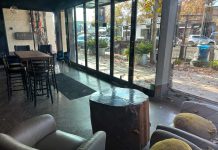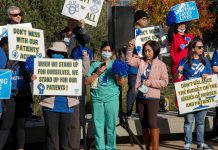The iconic yet long-neglected “Red Barn,” as locals call it, lodged within Christmas Hill Park has existed on borrowed time ever since the City Council called off the bulldozers last February, following an impassioned plea from the president of the Gilroy Historical Society, Connie Rogers.
Since then, supporters formed the Save the Red Barn Committee with the goal of just that, garnering enough support to block demolition and collect ideas to find a new purpose for the facility, one that has sat boarded-up and fenced off since the 1990s. The committee’s members have been digging into the structure’s history, the land it sits on, its original owner and its overall historical significance—and they’re adamant that the barn is a valuable resource that could become an asset for the community. But if it comes down, as demolition is slated for February 2015, the group says Gilroy will lose a significant chunk of its storied past.
The barn itself is more than a century old-and possibly much older, committee members say—and it belonged to one of the most influential cattlemen in American history, the late German-born cattle baron Henry Miller, who called Gilroy his home. By the time of his death in 1916, Miller owned between 3.5 and 4.5 million acres in the Western states, and he controlled much more, according to committee member Kathy Chavez said.
While Miller’s influence across California is well documented, with statues, schools and parks erected in his name still standing in towns like Los Banos, his mark on Gilroy is still visible today. Miller donated the parcel that eventually became Gilroy’s Miller Park, and before his death, he bequeathed $15,000 to the city of Gilroy for the poor. That money still sits in the city’s account, and as the principal collects interest, that money is donated locally, committee member Carol DeSantis explained.
“It’s not just about Miller. We’re looking at it as the physical embodiment of Gilroy’s history,” Chavez said. “If we lose this (the barn), we’re losing a big chunk of what Gilroy is. That’s why we’re so passionate about this.”
Chavez and fellow committee member Richard Perino, native-born Gilroyans, said they’ve watched over the years as historic buildings were knocked down, burned down or fell on their own—and there’s very little left that represents Gilroy’s heritage. Over the years, community members have gotten together to protest the demolition of historic structures, and this time is no different.
“We all agree it’s a symbol of Gilroy’s agricultural past and it needs to be preserved. What we use it for, we all have different ideas,” said committee member Gary Walton, who researched Miller at UC Berkeley’s Bancroft Library. “The barn is important because it transmits the history of this community to new people who move here and know nothing of Gilroy. It’s important to have people grounded in your histories and traditions when they move here because they feel part of the community. Our community is only as good as its distinctiveness compared to other communities and they become homogenized if that gets lost. Then, there’s no reason to come here because there’s nothing the other communities don’t have. We have to start preserving and caring about the people who came before us.”
From a community garden to a potential venue for folk music festivals or even the home of a farmers market, the seven-member committee has no shortage of ideas for what the Red Barn could be used for someday, but the main thrust at this point is saving the barn by garnering support for its preservation and raising awareness that the city has plans to demolish it.
The group has also been reaching out to other groups dedicated to saving agricultural facilities like the Red Barn, and they’ve learned that it’s possible to re-purpose an old facility and turn it into an asset for the entire community. Pointing to the Agriculture Park in Watsonville, the committee says family-friendly events could be held at the Red Barn, and students could even take tours and learn about Gilroy’s agricultural history.
“As the Glen Loma Ranch develops out, we’re going to have a lot more people out there. I think it would be an asset for that community to have that open space, agriculture and the history,” Walton said. “The Emma Prusch Park (in San Jose) has community gardens. How cool would it be if they could bike to their garden plot?”
During one of the group’s fundraising events, a young man donated his birthday money to the campaign to save the barn, according to Chavez.
“I was very touched by that gesture. It was special,” she added, holding back tears. “It means this isn’t an old white people campaign, but young people actually care too. They’re just as enthusiastic as we are about saving the barn.”
“Too many kids, I think, think that eggs come from Safeway and milk comes in containers,” Walton added. “I think it would be short-sighted to tear this down and not see the asset that it really could become. I think the city needs to open their eyes and really reach out to the community for their ideas of what is possible on that site, and learn the lessons from other communities that have saved their agricultural properties.”
For more information about the committee’s efforts, visit their Facebook page at https://www.facebook.com/savemillerredbarn.
“I think it would be short-sighted to tear this down and not see the asset that it really could become. I think the city needs to open their eyes and really reach out to the community for their ideas of what is possible on that site, and learn the lessons from other communities that have saved their agricultural properties.”
-Save the Red Barn Committee member Gary Walton














